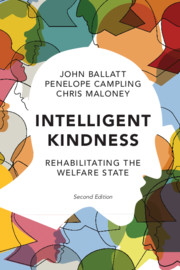Book contents
- Intelligent Kindness
- Reviews
- Intelligent Kindness
- Copyright page
- Contents
- Foreword
- Authors’ Note
- Chapter 1 The Heart of the Matter
- Chapter 2 Rescuing Kindness
- Chapter 3 A Politics of Kindness
- Chapter 4 Building the Case for Kindness
- Chapter 5 Managing Feelings of Love and Hate
- Chapter 6 The Emotional Life of Teams
- Chapter 7 Cooperation and Fragmentation
- Chapter 8 On the Edges of Kinship
- Chapter 9 Unsettling Times
- Chapter 10 Free to Serve the Public?
- Chapter 11 Blame
- Chapter 12 The Hostile Environment
- Chapter 13 The Pull towards Perversion
- Chapter 14 Cultivating Intelligent Kindness
- Chapter 15 Rehabilitating the Welfare State
- Index
- About the Authors
- Acknowledgements
- References
Chapter 11 - Blame
Published online by Cambridge University Press: 28 February 2020
- Intelligent Kindness
- Reviews
- Intelligent Kindness
- Copyright page
- Contents
- Foreword
- Authors’ Note
- Chapter 1 The Heart of the Matter
- Chapter 2 Rescuing Kindness
- Chapter 3 A Politics of Kindness
- Chapter 4 Building the Case for Kindness
- Chapter 5 Managing Feelings of Love and Hate
- Chapter 6 The Emotional Life of Teams
- Chapter 7 Cooperation and Fragmentation
- Chapter 8 On the Edges of Kinship
- Chapter 9 Unsettling Times
- Chapter 10 Free to Serve the Public?
- Chapter 11 Blame
- Chapter 12 The Hostile Environment
- Chapter 13 The Pull towards Perversion
- Chapter 14 Cultivating Intelligent Kindness
- Chapter 15 Rehabilitating the Welfare State
- Index
- About the Authors
- Acknowledgements
- References
Summary
Blaming comes naturally to us all. If something goes wrong we readily blame others, or ourselves, depending upon our character. This has some uses, and can be a meaningful way of analysing a situation. In its most neutral form, blame is a matter of attributing responsibility for a fault, or wrong. This might be positive if it leads to learning from experience: but blaming is usually more than a simple causal analysis. It allows retribution, the meting out of punishment, and it also has emotional consequences, which are punitive in their own right. Blaming is also sometimes termed ‘naming and shaming’, and shame is a powerful and distressing thing to feel.
Punishment might make sure the same thing does not happen again: a primitive form of education. There is, however, another powerful driver for blame, related to revenge: it allows the discharge of painful and powerful emotion by those who have been, or feel, injured.
- Type
- Chapter
- Information
- Intelligent KindnessRehabilitating the Welfare State, pp. 152 - 170Publisher: Cambridge University PressPrint publication year: 2020



